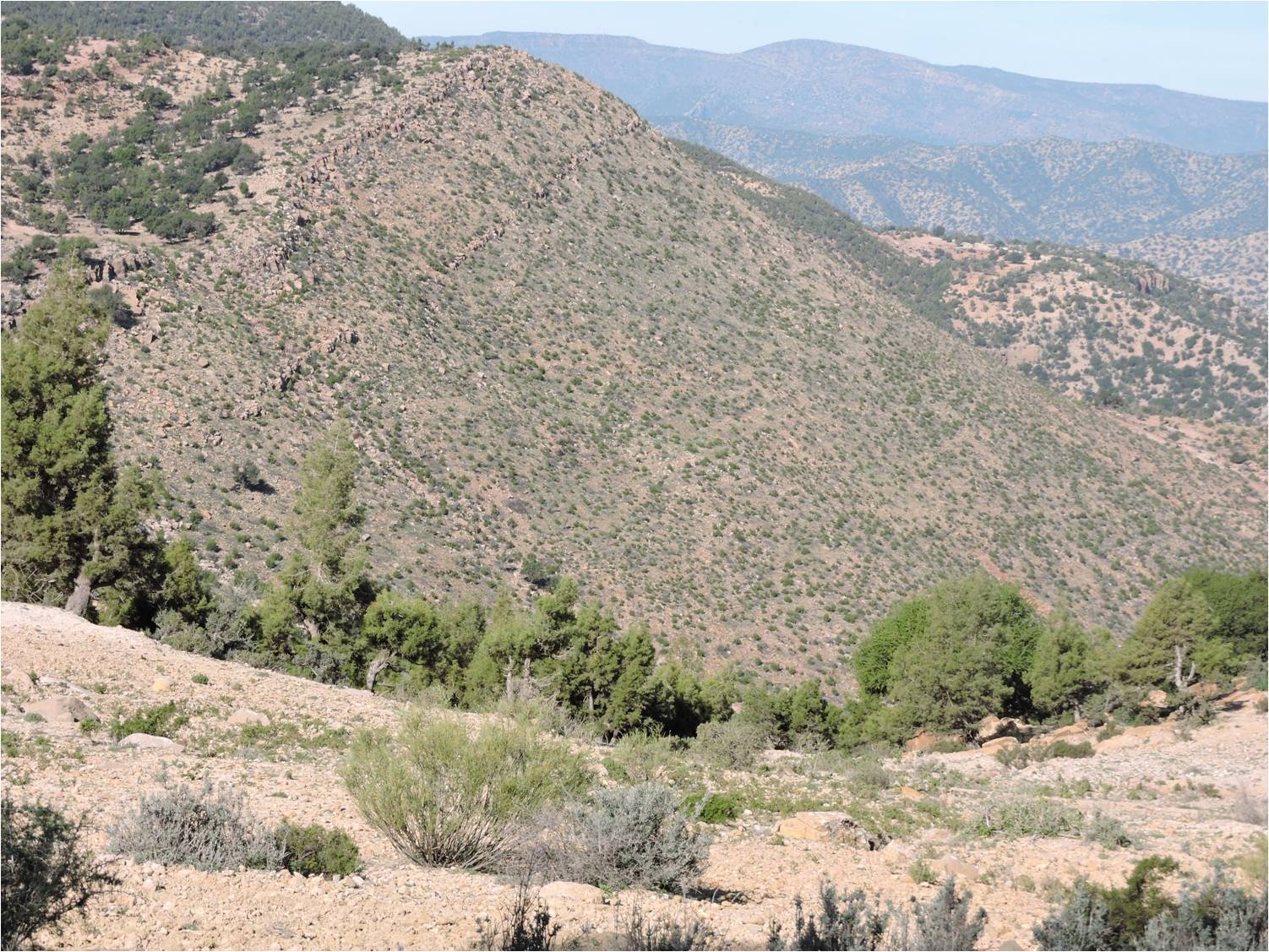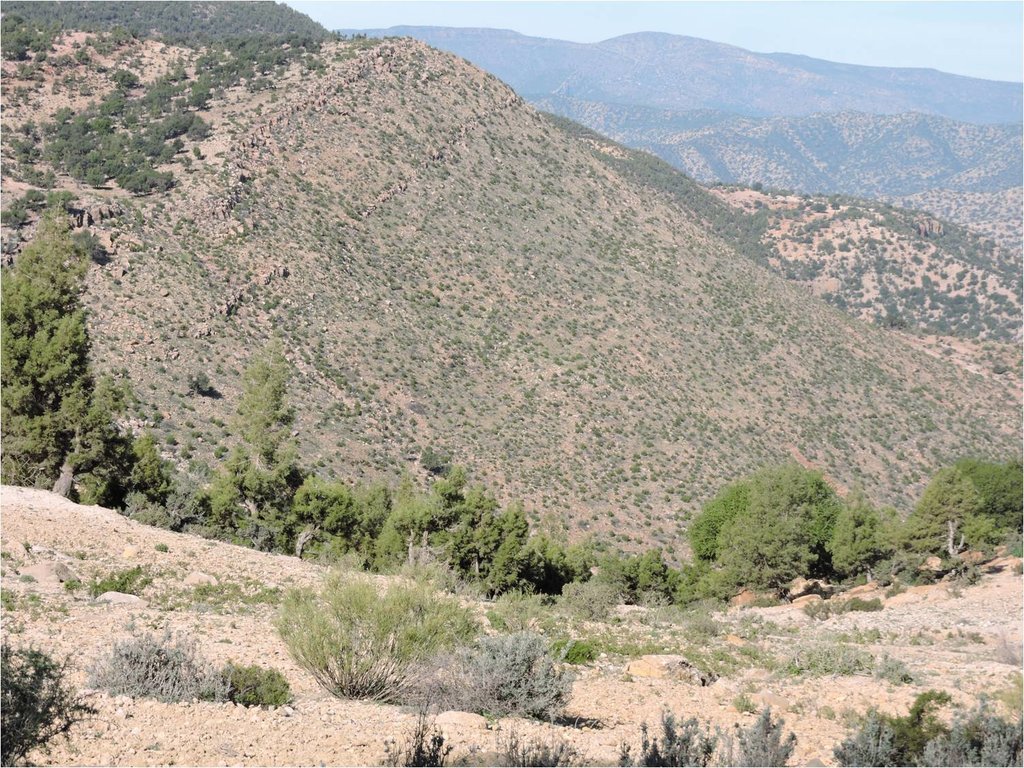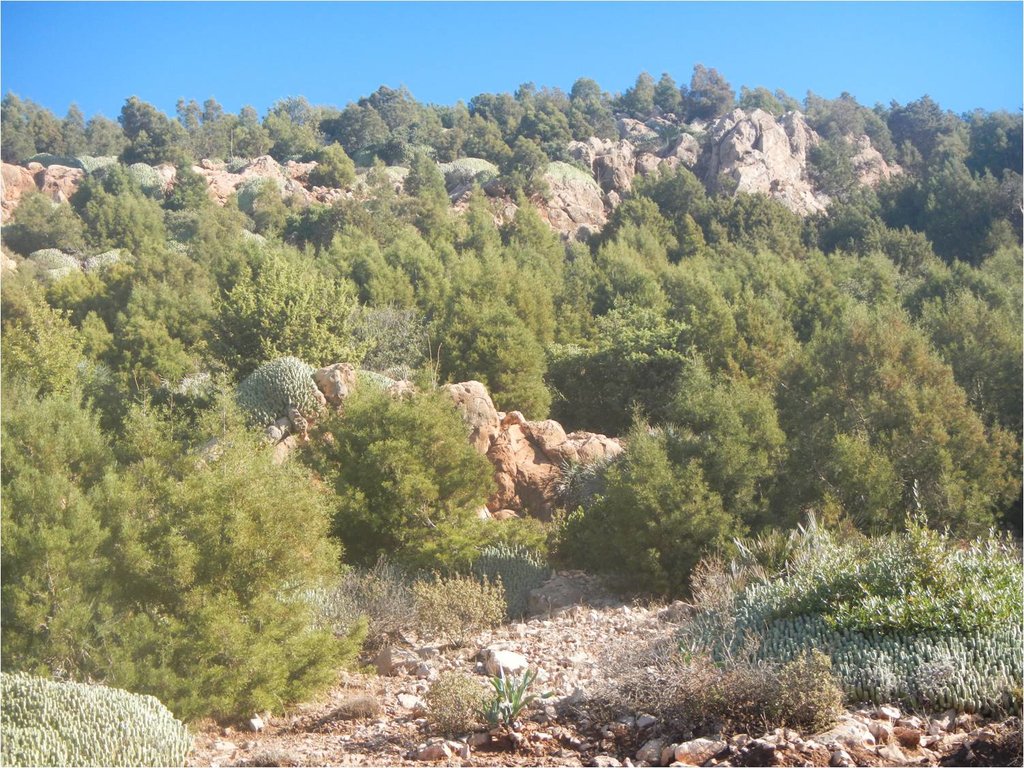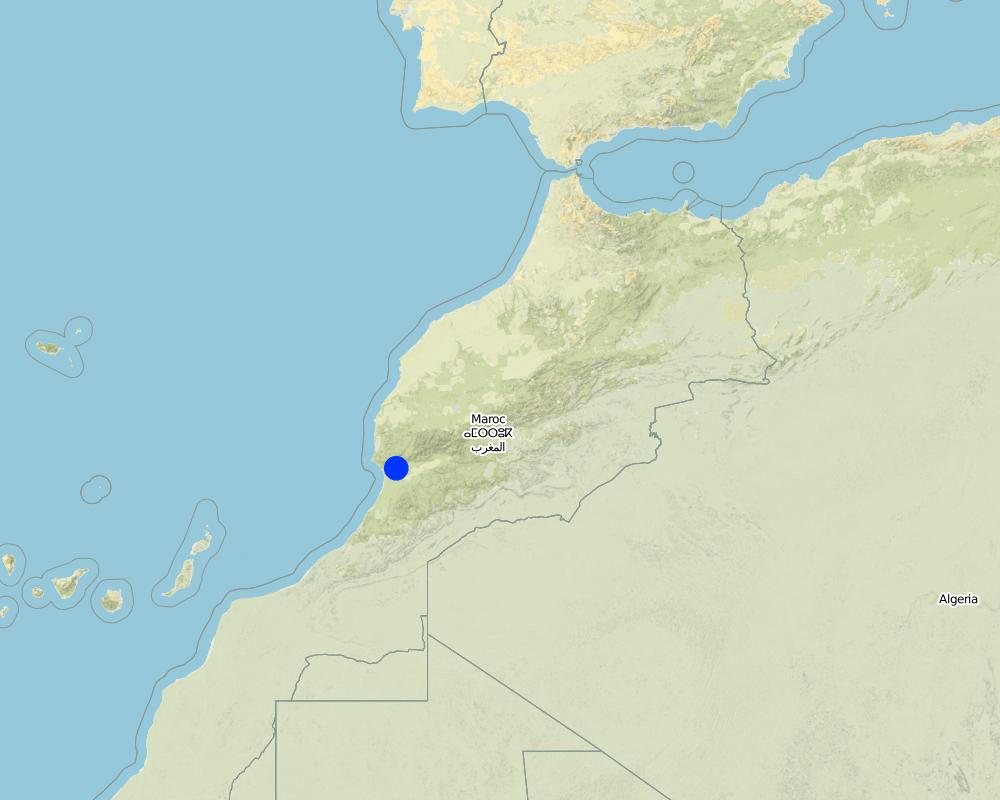Réhabilitation par mise en défens. [Morocco]
- Creation:
- Update:
- Compiler: Mohamed Sabir
- Editor: –
- Reviewers: Donia Mühlematter, Nicole Harari, Rima Mekdaschi Studer
Mise en défens
technologies_3210 - Morocco
View sections
Expand all Collapse all1. General information
1.2 Contact details of resource persons and institutions involved in the assessment and documentation of the Technology
SLM specialist:
Didi Alaoui Ahmed
00212619110331
Haut Commissariat aux Eaux et Forêts et à la Lutte contre la Désertification
DREFLC, Agadir, Secteur Amskroud
Morocco
SLM specialist:
Name of project which facilitated the documentation/ evaluation of the Technology (if relevant)
Decision Support for Mainstreaming and Scaling out Sustainable Land Management (GEF-FAO / DS-SLM)Name of the institution(s) which facilitated the documentation/ evaluation of the Technology (if relevant)
Royaume du Maroc, Haut Commissariat aux Eaux et Forêts et à la Lutte Contre la Désertification (Royaume du Maroc) - Morocco1.3 Conditions regarding the use of data documented through WOCAT
When were the data compiled (in the field)?
06/01/2017
The compiler and key resource person(s) accept the conditions regarding the use of data documented through WOCAT:
Yes
1.4 Declaration on sustainability of the described Technology
Is the Technology described here problematic with regard to land degradation, so that it cannot be declared a sustainable land management technology?
No
1.5 Reference to Questionnaire(s) on SLM Approaches
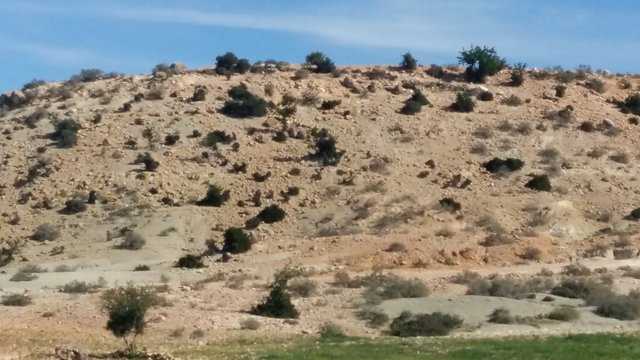
Reconstitution et réhabilitation des écosystèmes forestiers [Morocco]
La reconstitution et la réhabilitation des forêts répondent aux objectifs et missions des gestionnaires visant la pérennité des peuplements forestiers.
- Compiler: Mohamed Sabir
2. Description of the SLM Technology
2.1 Short description of the Technology
Definition of the Technology:
Interdiction d'accès aux animaux (pâturage direct et indirect) pour assurer la dynamique progressive de la végétation et son développement.
2.2 Detailed description of the Technology
Description:
La mise en défens est instauré après l'incendie de forêt de 2011.
En plus de la l'interdiction des usages habituels de la population locale (paturage, ramassage du bois mort, etc) et tous les sujets incendiés sont recépés.
Avec uniquement l'exclusion des usages habituels et le respect de la mise en défens on attend une reprise de la végétation spontannée naturellement.
La restriction au parcours et autres activités humaines de prélèvement de produit est une mesure qui ne peut être efficace que grace à l'adhésion des usagers pour le respect de la mis en défens. Dans ce cas, les usagers se sont organisés en association et bénéficient de la compensation à raison de 350 dh/an/ha en application de la réglementation relative à la suspension des droits d'usages mise au point depuis 2002.
Après 5 à 6 ans de mise en défens, on remarque bien que la mise en défens a donné des résultats très satisfaisants en matère de réhabilitation du couvert arboré et du développement des espèces locales.
2.3 Photos of the Technology
2.5 Country/ region/ locations where the Technology has been applied and which are covered by this assessment
Country:
Morocco
Region/ State/ Province:
Agadir et tout le pays
Further specification of location:
Commune d'Amskroud
Comments:
Zone jbel Tirghoudine - Sloum Iguenane (Commune d'Amskroud)
Map
×2.6 Date of implementation
Indicate year of implementation:
2012
2.7 Introduction of the Technology
Specify how the Technology was introduced:
- as part of a traditional system (> 50 years)
3. Classification of the SLM Technology
3.1 Main purpose(s) of the Technology
- improve production
- protect a watershed/ downstream areas – in combination with other Technologies
- preserve/ improve biodiversity
3.2 Current land use type(s) where the Technology is applied

Grazing land
Extensive grazing land:
- Semi-nomadism/ pastoralism
Main animal species and products:
Caprins

Forest/ woodlands
Products and services:
- Fruits and nuts
- Other forest products
- Grazing/ browsing
- Nature conservation/ protection
Comments:
Toute utilisation est suspendue actuellement.
If land use has changed due to the implementation of the Technology, indicate land use before implementation of the Technology:
- Pâturages sur des prairies naturelles ou semi-naturelles, prairies arborées/ arbustives (savanes) ou boisement ouvert pour l’élevage ou la faune sauvage.
- Forêts composées principalement d’arbres indigènes non plantés par l’homme.
3.3 Further information about land use
Water supply for the land on which the Technology is applied:
- rainfed
Number of growing seasons per year:
- 1
3.4 SLM group to which the Technology belongs
- natural and semi-natural forest management
- pastoralism and grazing land management
- improved ground/ vegetation cover
3.5 Spread of the Technology
Specify the spread of the Technology:
- evenly spread over an area
If the Technology is evenly spread over an area, indicate approximate area covered:
- 10-100 km2
3.6 SLM measures comprising the Technology

management measures
- M2: Change of management/ intensity level
3.7 Main types of land degradation addressed by the Technology

soil erosion by water
- Wt: loss of topsoil/ surface erosion

biological degradation
- Bc: reduction of vegetation cover
- Bh: loss of habitats
3.8 Prevention, reduction, or restoration of land degradation
Specify the goal of the Technology with regard to land degradation:
- restore/ rehabilitate severely degraded land
4. Technical specifications, implementation activities, inputs, and costs
4.1 Technical drawing of the Technology
4.2 Technical specifications/ explanations of technical drawing
La mise en défens est une mesure soft qui consiste à installer la restriction aux activités humaine (pâturage, bois, etc) qui ne demande aucun investissement sur le terrain (cloture, etc). Le gardiennage est payé avant l'engagement des usagers à respecter la mise en défens, La population est responsabilisée et le gardiennage est assuré par eux même.
4.3 General information regarding the calculation of inputs and costs
Specify how costs and inputs were calculated:
- per Technology area
Indicate size and area unit:
750 ha
Specify currency used for cost calculations:
- US Dollars
Indicate exchange rate from USD to local currency (if relevant): 1 USD =:
10.0
Indicate average wage cost of hired labour per day:
1200 dhs/mois (prise en charge par l'association)
4.4 Establishment activities
| Activity | Type of measure | Timing | |
|---|---|---|---|
| 1. | Recepage et nettoiement des arbres et arbustes incendiés | Vegetative | Après incendie 2012 |
| 2. | Sensibilisation des usagers | Structural | 2012 |
| 3. | Mise au point de contrat de compensation et engagement des usagers au respect de la mise en défens | Agronomic | 2013 |
4.5 Costs and inputs needed for establishment
| Specify input | Unit | Quantity | Costs per Unit | Total costs per input | % of costs borne by land users | |
|---|---|---|---|---|---|---|
| Labour | Recepage | ha | 750.0 | 1000.0 | 750000.0 | |
| Total costs for establishment of the Technology | 750000.0 | |||||
If land user bore less than 100% of costs, indicate who covered the remaining costs:
Etat / Service des Eaux et Forêts
Comments:
Le respect et le gardiennage des mises en défens est composé à raison de 350 dirhams/ha/an (35 USD). La main d'oeuvre est payée de ce montant de la compensation.
4.6 Maintenance/ recurrent activities
| Activity | Type of measure | Timing/ frequency | |
|---|---|---|---|
| 1. | Montant de la compensation annuelle | Management | Novembre |
4.7 Costs and inputs needed for maintenance/ recurrent activities (per year)
| Specify input | Unit | Quantity | Costs per Unit | Total costs per input | % of costs borne by land users | |
|---|---|---|---|---|---|---|
| Other | Compensation mise en défens | ha | 750.0 | 35.0 | 26250.0 | |
| Total costs for maintenance of the Technology | 26250.0 | |||||
If land user bore less than 100% of costs, indicate who covered the remaining costs:
Etat
Comments:
Les usagers contribuent en nature par le gardiennage assuré spontannement par tous les membres.
5. Natural and human environment
5.1 Climate
Annual rainfall
- < 250 mm
- 251-500 mm
- 501-750 mm
- 751-1,000 mm
- 1,001-1,500 mm
- 1,501-2,000 mm
- 2,001-3,000 mm
- 3,001-4,000 mm
- > 4,000 mm
Specify average annual rainfall (if known), in mm:
150.00
Agro-climatic zone
- arid
5.2 Topography
Slopes on average:
- flat (0-2%)
- gentle (3-5%)
- moderate (6-10%)
- rolling (11-15%)
- hilly (16-30%)
- steep (31-60%)
- very steep (>60%)
Landforms:
- plateau/plains
- ridges
- mountain slopes
- hill slopes
- footslopes
- valley floors
Altitudinal zone:
- 0-100 m a.s.l.
- 101-500 m a.s.l.
- 501-1,000 m a.s.l.
- 1,001-1,500 m a.s.l.
- 1,501-2,000 m a.s.l.
- 2,001-2,500 m a.s.l.
- 2,501-3,000 m a.s.l.
- 3,001-4,000 m a.s.l.
- > 4,000 m a.s.l.
Indicate if the Technology is specifically applied in:
- not relevant
5.3 Soils
Soil depth on average:
- very shallow (0-20 cm)
- shallow (21-50 cm)
- moderately deep (51-80 cm)
- deep (81-120 cm)
- very deep (> 120 cm)
Soil texture (topsoil):
- coarse/ light (sandy)
Soil texture (> 20 cm below surface):
- coarse/ light (sandy)
Topsoil organic matter:
- medium (1-3%)
5.4 Water availability and quality
Ground water table:
on surface
Is water salinity a problem?
No
Is flooding of the area occurring?
No
5.5 Biodiversity
Species diversity:
- medium
Habitat diversity:
- medium
5.6 Characteristics of land users applying the Technology
Sedentary or nomadic:
- Sedentary
Market orientation of production system:
- subsistence (self-supply)
Off-farm income:
- 10-50% of all income
Relative level of wealth:
- poor
Individuals or groups:
- groups/ community
Level of mechanization:
- manual work
Gender:
- men
Age of land users:
- youth
- middle-aged
5.7 Average area of land owned or leased by land users applying the Technology
- < 0.5 ha
- 0.5-1 ha
- 1-2 ha
- 2-5 ha
- 5-15 ha
- 15-50 ha
- 50-100 ha
- 100-500 ha
- 500-1,000 ha
- 1,000-10,000 ha
- > 10,000 ha
Comments:
Espace du domaine de l'état dont la population possède seulement le droit d'usage.
5.8 Land ownership, land use rights, and water use rights
Land ownership:
- state
- suspendu
Water use rights:
- individual
Comments:
Droit d'utilisation suspendu par la mise en défens.
5.9 Access to services and infrastructure
health:
- poor
- moderate
- good
education:
- poor
- moderate
- good
technical assistance:
- poor
- moderate
- good
employment (e.g. off-farm):
- poor
- moderate
- good
markets:
- poor
- moderate
- good
energy:
- poor
- moderate
- good
roads and transport:
- poor
- moderate
- good
drinking water and sanitation:
- poor
- moderate
- good
financial services:
- poor
- moderate
- good
6. Impacts and concluding statements
6.1 On-site impacts the Technology has shown
Socio-economic impacts
Production
fodder production
Comments/ specify:
Non utilisable
forest/ woodland quality
Quantity before SLM:
brulé
Quantity after SLM:
En réhabilitation
Socio-cultural impacts
land use/ water rights
Comments/ specify:
Suspendu
Ecological impacts
Water cycle/ runoff
surface runoff
Comments/ specify:
Réhabilitation du couvert
Soil
soil cover
Quantity before SLM:
brulé
Quantity after SLM:
En réhabilitation
soil loss
Comments/ specify:
En réhabilitation
Biodiversity: vegetation, animals
Vegetation cover
biomass/ above ground C
Climate and disaster risk reduction
flood impacts
6.2 Off-site impacts the Technology has shown
downstream flooding
Quantity before SLM:
dénudé
Quantity after SLM:
réhabilitation
Comments/ specify:
Couvert sol
6.3 Exposure and sensitivity of the Technology to gradual climate change and climate-related extremes/ disasters (as perceived by land users)
Gradual climate change
Gradual climate change
| Season | Type of climatic change/ extreme | How does the Technology cope with it? | |
|---|---|---|---|
| seasonal temperature | spring | decrease | moderately |
| annual rainfall | decrease | not well | |
| seasonal rainfall | decrease | moderately |
Climate-related extremes (disasters)
Climatological disasters
| How does the Technology cope with it? | |
|---|---|
| drought | not well |
| forest fire | moderately |
6.4 Cost-benefit analysis
How do the benefits compare with the establishment costs (from land users’ perspective)?
Short-term returns:
very negative
Long-term returns:
neutral/ balanced
How do the benefits compare with the maintenance/ recurrent costs (from land users' perspective)?
Short-term returns:
neutral/ balanced
Long-term returns:
positive
6.5 Adoption of the Technology
Of all those who have adopted the Technology, how many have did so spontaneously, i.e. without receiving any material incentives/ payments?
- 50-90%
Comments:
La technologie est adoptée par le département des forêts. L'application est sous la responsabilité des usagers pour recevoir en contre partie la compensation en vigueur.
6.6 Adaptation
Has the Technology been modified recently to adapt to changing conditions?
No
6.7 Strengths/ advantages/ opportunities of the Technology
| Strengths/ advantages/ opportunities in the land user’s view |
|---|
| Facilite la reconstitution des forêts |
| Réhabilitation des espèces végétales et animales |
| Strengths/ advantages/ opportunities in the compiler’s or other key resource person’s view |
|---|
| Un moyen efficace pour la réhabilitation des ecosystèmes présentant un potentiel écologique important |
| Cette technologie engage moins de frais pour la réhabilitation des écosystèmes forestiers |
6.8 Weaknesses/ disadvantages/ risks of the Technology and ways of overcoming them
| Weaknesses/ disadvantages/ risks in the land user’s view | How can they be overcome? |
|---|---|
| Superficie importante est mise en défens | Réhabilitation progressive |
| Taux faible de la compensation. | Augmentation du taux de la compensation |
| Weaknesses/ disadvantages/ risks in the compiler’s or other key resource person’s view | How can they be overcome? |
|---|---|
| Opposition de certains usagers | Nécessité d'engager la responsabilité des usagers dans ce type d'action |
7. References and links
7.1 Methods/ sources of information
- field visits, field surveys
Plusieurs visites dans le cadre des projets de recherche-développement.
- interviews with SLM specialists/ experts
Chef de secteur et reponsables provinciaux.
Links and modules
Expand all Collapse allLinks

Reconstitution et réhabilitation des écosystèmes forestiers [Morocco]
La reconstitution et la réhabilitation des forêts répondent aux objectifs et missions des gestionnaires visant la pérennité des peuplements forestiers.
- Compiler: Mohamed Sabir
Modules
No modules


